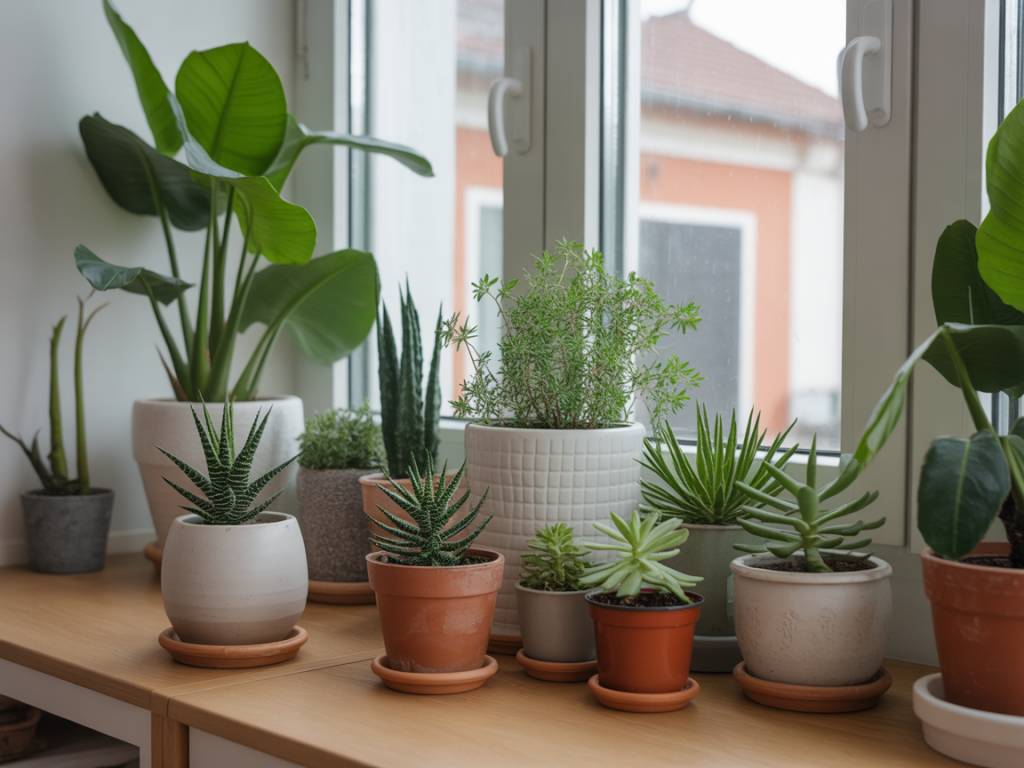Why Air-Purifying Plants Are Essential in a Tiny Home
Living in a tiny house comes with many benefits: lower environmental impact, reduced costs, and a simpler lifestyle. But one important factor often overlooked is indoor air quality. Due to limited space, modern insulation, and fewer windows, tiny homes can accumulate indoor pollutants more quickly than traditional houses. Dust, mold spores, chemicals from furniture, and limited ventilation can create a stagnant environment.
This is where air-purifying plants come in. These natural detoxifiers not only beautify your interior but also work silently to improve air quality. Incorporating the right houseplants into your space can make a significant difference, even in compact square footage. Let’s explore the best air-purifying plants for tiny homes, how they work, and how to care for them in small spaces.
How Air-Purifying Plants Improve Indoor Air Quality
NASA famously conducted a Clean Air Study that identified the ability of certain plants to filter out volatile organic compounds (VOCs) such as benzene, formaldehyde, and trichloroethylene. These chemicals often originate from common household items such as paint, cleaning products, and synthetic building materials—all of which are found in tiny homes too.
Plants absorb these harmful toxins through their leaves and roots, converting them into harmless byproducts or storing them in their structure. At the same time, they release oxygen and increase humidity levels, creating a healthier, more breathable indoor environment.
Top Air-Purifying Plants That Thrive in Tiny Houses
Not all houseplants are created equal. When it comes to compact interiors, the best plants are those that require minimal care, thrive in low to moderate light, and have powerful purification properties.
- Snake Plant (Sansevieria trifasciata): Often referred to as « mother-in-law’s tongue », this hardy plant is ideal for tiny homes. It can survive in low light and infrequent watering. Best of all, it continues to produce oxygen at night, making it perfect for the bedroom.
- Spider Plant (Chlorophytum comosum): Easy to grow and highly effective at removing carbon monoxide and formaldehyde, the spider plant is great for beginners. Its arching green and white leaves add a soft, organic touch to vertical spaces or hanging planters.
- Peace Lily (Spathiphyllum): Known for its elegant white blooms, the peace lily also fights off common VOCs and mold spores. It thrives in low light, but does need regular watering—making it perfect for the kitchen or bathroom.
- Pothos (Epipremnum aureum): A trailing plant that’s easy to train around shelves or window frames, pothos is a gem for space-saving decor. It’s extremely effective at filtering benzene and formaldehyde and adapts well to various light conditions.
- Bamboo Palm (Chamaedorea seifrizii): If you’re craving a touch of the tropics, this plant is ideal. It filters out formaldehyde and benzene and adds a luxurious texture to your interiors. Its vertical growth makes it a good fit in corners or alongside furniture.
- Aloe Vera: Not just for skin care, aloe vera also purifies the air by removing harmful chemicals often found in cleaning agents. It likes sunny spots and requires minimal watering.
- English Ivy (Hedera helix): A versatile vine that’s excellent at neutralizing airborne mold particles—making it particularly useful for people with allergies. It can be trained into hanging baskets or allowed to trail along windowsills.
Maximizing Space: Where to Place Plants in a Small Home
In a tiny house, floor space is precious. Choosing the right placement strategies is key to enjoying greenery without sacrificing functionality. Think vertically: hanging planters, wall-mounted shelves, and corner stands can all be effective ways to display your plants and optimize airflow.
Here are some space-saving ideas:
- Wall Shelves: Staggered or floating shelves allow for a small plant collection without crowding your workspace or kitchen counters.
- Hanging Baskets: Especially useful in front of windows, hanging containers provide light exposure and stay out of the way.
- Window Ledges: Succulents and small potted plants do well on sunny sills, catching light while foregoing extra furniture.
- Bathroom Corners: Peace lilies and pothos love humidity and can thrive in the steam from showers.
- Kitchen Counter Nooks: Use vertical risers to double your counter utility and add greenery next to your herbs and spices.
Care Tips for Plants in Compact Living Spaces
Even hardy houseplants need some attention to flourish, especially in small, variable environments like tiny homes. Because of limited ventilation and the use of wood stoves or electric heating, temperatures and humidity can fluctuate quickly. Here are a few key care tips:
- Monitor Light Levels: Use sheer curtains to diffuse harsh direct sunlight and rotate plants weekly to ensure even growth.
- Water Sparingly: Due to humidity and limited evaporation, overwatering is a common mistake. Always check soil moisture before watering.
- Clean the Leaves: Dusty leaves can block sunlight and reduce air purification. Wipe with a damp cloth monthly for best results.
- Use Lightweight Pots: Choose compact or hanging containers that are easy to move and won’t overpower a small interior.
- Group Plants Strategically: Grouping humidity-loving plants together can create beneficial micro-environments and reduce the amount of watering needed.
Enhancing Aesthetics by Integrating Plants into Interior Design
Beyond their health benefits, air-purifying plants add life, color, and a sense of calm to the visual atmosphere. In small spaces where every design element matters, plants can serve as focal points, texture elements, or even organic partitions.
Here are a few decorative ideas:
- Mix Planter Styles: Incorporate ceramic, terracotta, or minimalist planters to reflect your home’s design theme—be it Scandinavian, rustic, or modern minimalist.
- Create a Living Wall: Modular vertical garden kits allow you to build a « green wall » without taking up square footage.
- Terrariums and Glass Domes: Perfect for desktops or shelves, small contained plant displays add elegance and require little maintenance.
- Natural Partitions: Use taller plants like the bamboo palm or rubber plant to subtly separate spaces—such as differentiating a sleeping area from a work zone.
Choosing the Right Air-Purifying Plants for Your Lifestyle
Pick plants not just for their detoxifying powers but based on how much time and care you’re willing to invest. If you’re often away or have limited light, try snake plants, pothos, or ZZ plants (Zamioculcas zamiifolia). If you enjoy more interaction and have ample filtered light, ferns, philodendrons, or palms can be excellent choices.
Also consider whether you have pets, as some plants like peace lilies and aloe can be toxic if ingested. Always double-check pet-safe options if this applies to your living situation.
In the end, air-purifying plants are more than just decorative accessories—they’re living, breathing elements that contribute to the health and aesthetic of your tiny home. With a thoughtful approach to selection and placement, even a modest space can transform into a vibrant, eco-friendly sanctuary.

